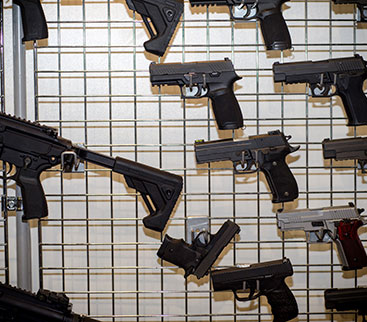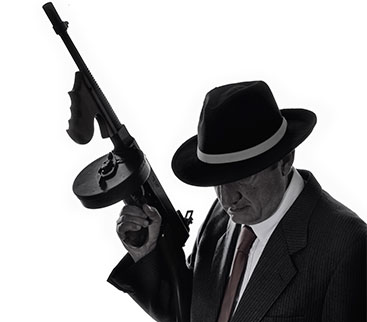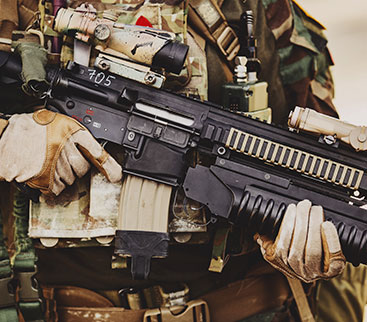We Need To Talk: Getting Your Terminology Straight
Today, many in the U.S. get their information from two main sources – the media, which comes in a variety of forms, and our online community which is primarily made up of “friends” we’ve either lost touch with or have never even met in person. While there are plenty of reputable sources in both camps, there is a pretty large segment – a popular and shareable segment – that are not. No matter how much you share that info or how frequently you’ve seen or heard it – doesn’t make the info there true or even factually-based.
This is, of course, an important thing to keep in mind when taking a stance on hot-button topics like gun control. And while it might be impossible to really bridge the divide between the gun-control and gun-rights movements it’s important to remember that it’s impossible to start a dialogue when you don’t know what the hell you are talking about. Take a minute to learn a little about whatever topic you feel passionate about, (whether that’s gun control or something else), and remember that understanding the topic better will do nothing but help, because sticking our fingers in our ears and pretending what the other side has to say isn’t going to get the job done.
Today, we’ll cover some commonly misused gun jargon or terminology because there are a lot of terms that are misused and confused in this gun-reform debate… because let’s face it, we need to talk.
Semi-Automatic vs. Automatic Firearms
When it comes to debating with a gun-enthusiast or gun-rights activist, the term semi-automatic gets misused a lot. In fact, this is probably the biggest deal to second-amendment activists because when it’s misused it scares the hell out of them. Why? Because the statements made on the pro-reform side go something like, “We don’t want to ban all guns, just the semi-automatic ones” or “No one needs a semi-automatic weapon.” To those who understand what that word means, that’s a scary use of a word they don’t understand because so many firearms fall into this category – not just the weapons most people making this statement seem to really mean when they’re pushing for reform. Of course, there are some extreme views that do mean exactly what they’re saying here because they want to ban all guns, but when you talk to the individuals the vast majority of them have no idea what they’re really saying.
For those who don’t understand the terminology here, let’s cover some of the basics. A semi-automatic firearm is one that not only fires a bullet each time the trigger is pulled but also performs all the mechanical steps needed to prepare itself to discharge again at the next trigger pull. It’s referred to as “semi-automatic” because the round is cycled automatically with a single trigger pull¹. Semi-automatic firearms have been around for over 100 years and all major types of firearms, rifles, shotguns, and handguns have semi-automatic versions. It’s a commonly misunderstood term in today’s gun debate because our info-sharers have failed to teach us the important distinction between this and an automatic firearm.


An automatic firearm, sometimes called “fully-automatic” or “full-auto”, continuously fires rounds as long as the trigger is held down and ammunition is present². Depending on the gun, automatic weapons can fire hundreds of rounds a minute. With a fully-automatic firearm, both the action and the trigger pull creates an automatic cycle, meaning that if you pull and hold the trigger the firearm will continue to fire until you let go of the trigger or it runs out of ammo – and how fast it’s capable of doing this depends on the mechanics of the gun itself, so it varies.
Fully-automatic weapons have been tightly regulated, but not prohibited, since Congress passed that National Firearms Act (NFA) of 1934, which outlawed the popular “Tommy Gun” pictured above at the time, and was amended in 1968 and again in 1986 when the revision to prohibit the transfer or possession of machine guns (with the exception of any that were lawfully owned before May 19, 1986), was added. There’s a NFA handbook of rules and regulations that’s 220 pages long and outlines all the federal regulations for automatic rifles/machine guns as well as other NFA firearms – which, short of outright prohibition, means these weapons are subject to just about every rule and restriction that has been proposed by opponents of easy civilian possession.
This misuse of terminology makes dialogue for change between gun-rights and gun-reform activists nearly impossible because the words here make all the difference in that call for change. So, it’s important to understand when you use the words “semi-automatic” to describe the weapons you wish to regulate – if it’s not an accurate portrayal of what you want here – it’s off-putting to the other side and will quickly shut down the exchange of meaningful discussion and ultimately the reform that many gun-owners are surprisingly open to discussing.
Assault Rifle vs. Assault Weapon
While most people think the “AR” in “AR-15” means “assault rifle”, it actually means “ArmaLite rifle”, after the company that developed it in the 1950’s. The term “assault rifle” is defined as a selective-fire rifle, (meaning it has the ability to fire in both semi-automatic and fully-automatic modes), that uses an intermediate cartridge and a detachable magazine³. As defined by the Defense Department it’s a “short, compact, selective-fire weapon that fires a cartridge intermediate in power between submachine gun and rifle cartridges.” So, by those definitions, the AR-15 is not an assault rifle. In fact, 99% of semi-automatic rifles in civilian hands are not assault rifles – they just have some cosmetic features that make the weapon look like one, not function like one.
There are some features being included in regulations on “assault weapons”, a newer term that’s still being defined every time there’s a new law drafted, that helps some semi-automatic weapons behave like automatic ones, though, like bump stocks and trigger modification devices. In 1994, President Clinton passed the Federal Assault Weapons Ban (AWB) to define “assault weapons” as a semi-automatic gun that accepts detachable magazines, has a pistol grip and sometimes other features like a forward grip, an adjustable or collapsible stock, or a flash suppressor or barrel shroud. The AWB was not renewed in 2004 when it expired, but it’s definition of “assault weapon” is present in much of the legislation both passed and in progress today.

While it might seem that these definitions would help the discussion, they don’t because there’s still a lot of grey area or vagueness to the guns this applies to. Plus, gun-rights advocates state that it invents a “scary sounding” class of firearms that are easily confused with “assault rifles” used by the military in an effort to rally support for an outright ban on these types of firearms. In a research article by Bruce H. Kobayashi and Joseph E. Olson published in the Stanford Law and Policy Review from 1997, they state that prior to 1989 the term ‘assault weapon’ didn’t exist in the lexicon of firearms and was a political term developed by anti-gun publicists to expand the category of ‘assault rifles’ to include those with the same cosmetic appearance.
So, gun-rights activists can’t come to grips with or get behind the regulations being imposed because they’re mostly centered around the cosmetic appearance of guns – not actual functionality. The fact that a rifle looks a certain way but functions the same as thousands of others, shouldn’t be the basis for these regulations. To them, they just don’t make sense. In the town hall discussion on February 21, 2018, held after the Marjory Stoneman Douglas shooting, Marco Rubio tried to explain this stance to the crowd – though his efforts largely fell on deaf ears. We could vote to put the AWB back in place, but we’re then choosing to ignore thousands of other guns that are functionally the same.
Rubio: “Are you in favor of banning any gun that can do what the AR-15 can do?”
Deutsch: Do I support banning “weapons of war that serve no purpose other than killing the maximum number of people they can? You bet I am”#StudentsStandUphttps://t.co/bIDrb7NKm2
— CNN Politics (@CNNPolitics) February 22, 2018
Rubio asked Ted Deutch during the town hall – “are you in favor of banning any gun that can do what the AR-15 can do?” Rubio stated that this is the heart of the debate on gun control right now. Deutch answered, “Do I support banning weapons that fire off 150 rounds in 7-8 minutes… weapons that are weapons of war that serve no purpose other than killing the maximum number of people they can, you bet I am.” Of course, this position by Deutch goes well beyond the AWB and is a stalling-point in this legislative movement and the discussion on the whole.
“Common Sense Gun Control”
You might be surprised to learn that many gun-rights advocates are open to changes in legislation to prevent mass shootings like those that happened in Orlando, Las Vegas, Parkland, and so many others. The divide we see right now between gun-rights and gun-reform activists isn’t about whether or not we need change – sure there’s some that are against, but the majority seems to be for some kind of change. The divide exists, deepening with every newscast or shared article online, because of this lack of agreement on what words we all use to describe our stance. Even the term “common sense gun control” deepens the divide. What it means from person to person varies… but we all assume our meaning is clear. The problem is, it just isn’t. It’s about as clear as mud.
If you want meaningful change, you need to express yourself in a way that is understood by others. And you can’t just stick your head in the sand or yell over someone with an opposing view to drown them out. Here at niof.org, we’re in favor of intelligent discussion and we want to hear your voice! We want to help you learn what the right words are and we want to understand and help facilitate meaningful change that’s agreeable to the majority. Please, leave a comment below to let us know your thoughts, take our latest poll about the types of “common sense gun control” you support, and join the discussion happening now in our chatroom.
Join in the Conversation!
![]()
We want to hear from you!
Join us on Discord - it's FREE.

This site is absolutely fabulous!